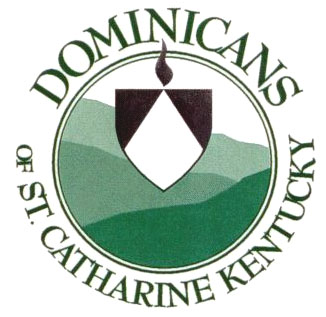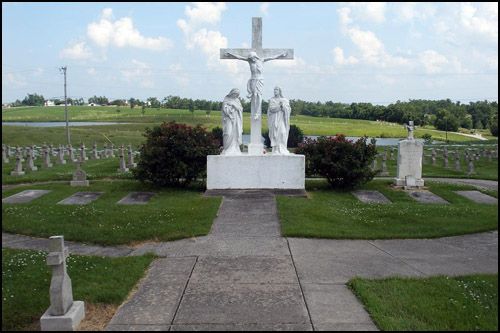On October 11, 1869, the New York Foundling Hospital was dedicated to the service of Christ's little ones. It was the Feast of the Maternity of Our Lady. Founders were Sister Mary Irene, Sister Teresa Vincent and Sister Ann Aloysia, all members of the religious community founded by Sister Elizabeth Anne Seton. The hospital prospered due to the work of Sister Mary Irene, Rev. Mother Mary Jerome and the other two Sisters mentioned above. Its success was due also to the vision, initiative, courage and support of Archbishop McCloskey, later Cardinal McCloskey. There were also many others, who by their dedication to God for the love of the small Child of Bethlehem, gave the love and warmth of a home to those for whom no stars seem to shine. New York Foundling Family Home This wonderful Foundling Family Home has an open heart for anybody who wished to use it. Sister Mary Irene with all the help and encouragement, and five dollars as her capital, opened the New York Foundling Asylum of the Sisters of Charity in the city of New York. It was incorporated on October 8, 1869. Three days later, on October 11, 1869, Feast of the Maternity of the Blessed Virgin, Sister Teresa Vincent and Sister Ann Aloysia moved into a small house at 17 East and 12th Street. They expected to spend three months in preparing for the opening of the institution. However, God willed otherwise. An infant was laid on their doorstep the very first night. Before January 1, 1870, the date they had planned to open, they had received 123 babies. After the Civil War, one of the most unpleasant of New York's social problems was the abandonment of infants in the streets of the city. Poverty, immigration, inadequate housing and the financial depression were most of the factors which made abandonment an ever present evil. A year later a larger house was procured for the Foundling Home; the state legislature authorized the city of New York to grant a site and appropriated $100,000 toward its erection. It also provided that a similar amount be raised through or by private contributions. The first home was on 17 East and 12th Street. The second was at 3 North Washington Square. The third New York Foundling Hospital, was at 175 East 68th Street. It was in operation at this site from 1873 to 1958. It covered at least two city blocks. After the first house was found to be inadequate to house all the children, another important development was inaugurated, the Boarding House Development. The Sisters asked their neighbors to care for some of the infants in their own homes. This was inaugurated on November 15, 1869. Adoption Department After Sister Irene was settled in the new building on 68th Street, she established the Adoption Department to find suitable permanent homes for these children who were legally free for adoption. Every care was taken to insure guardianship for each child. The first recorded placement of a child in a free home with a view to adoption was May 1873. Orphan Trains - Mercy Trains In later years, the adoption placement proceedings were improved by the installation of the "Orphan Train," later names "Mercy Trains." Although trains had been sent out even to the Midwest since 1876, this one was the first departure for the new administrator, Sister Teresa Vincent. The train was sent out in 1896. Now that it was May, the weeping willow in the east yard was downy with new green. "Strange not to have noticed it before," mused Sr. Teresa Vincent as she was listening to the nurses bustling around frantically. Sisters struggling with springy curls tried to ignore the delightful distraction of sending bands of children to foster homes in the Midwest. She shivered slightly as she thought of the homeless children she had to put on the train that afternoon. How lovely they looked when they had come to her for the final inspection -- sixty of them, the eldest barely six and the youngest toddler hardly more than two and a half. There was Teresa with the olive skin and the rose of far off Italy flaming in her little cheeks. There was Mary with the melting brown eyes and the golden hair; Joseph, a regular little elf and John with the tip tilted nose and the quizzical little face. Was the bell in the corridor always so loud? Or had it seemed that way when signaled the time for leaving. She had been close to tears then until little Freddy, bless him, had hoisted himself up on her rosary and pounded away with a joyful fists to be on the way to his new Mama and Papa. How interested onlookers were as the children were escorted by Sisters, nurses, and Grandpa McFeeley to the cars of the train. Soon there had been nothing but the sound of the train pounding in her heart. Mercy Train they called it. Even now she seemed to hear its far-off whistle as it sped through the countryside connecting city with city -- linking East with West -- forever entwining hearts with hearts. Sister Teresa Vincent was pondering these thoughts while she listened to the roar of the locomotive that told the story of a railway foster home program stretching from the sidewalks of New York to the towns of Nebraska and the stations along the sprawling mid-western plains. Within a few days there would be letters telling her the details she wanted to know. How wonderful the train ride had been...how fresh supplies of milk and other supplies had been picked up along the way...that parents had easily been identified through the tags attached to the children's clothes...and that there was happiness and love and hope. After all today had been the climax of many months of careful inquiry and investigation through agents and parish priests across the country. In this the suitability of the families offering to open their homes and hearts to her children had been established. Decisions had been made after long hours of fervent prayer, she reasoned. Surely her children had gone forth to live lives full of promise. Bishop travels by horse and buggy seeking homes for orphans In the year 1900 Bishop Thomas Bonacum, the first Bishop and spiritual leader of the diocese of Lincoln, Nebraska, traveled by horse and buggy seeking homes for the orphans from the New York City Foundling Home. These children would be coming on "Mercy Trains." This was before Bishop Bonacum founded and built St. Thomas Orphanage in Lincoln, Nebraska. Bishop Bonacum went to Exeter, Nebraska, to visit the pastor, Father Walter McDonald, in St. Stephen parish. He asked Father to announce at the Sunday Masses that the "Mercy Train" would be coming through Exeter on its way to Denver, Colorado. He said that any parents who wanted to adopt a child should inform the pastor and he would contact the Sisters at the Foundling Home in New York and give the names of the adoptive parents. As the train sped across the country it carried children whose clothes were labeled with a piece of linen. These labels had been prepared by the Sisters at the home. The name of the child, the name of the prospective foster parents and the date of birth of the child were written on these labels. They were sewed inside their traveling clothes. Orphan train stops in Exeter, Nebraska, on September 4, 1901 In the year 1901 a train load of fifty girls came from New York on the Burlington Railroad to Denver, Colorado. They were accompanied by two Sisters, nurses and an agent. This time the labels were sewed on the inside of the hem of their dresses. The foster parents had been notified that their child would arrive September 4, 1901. Duplicate identification cards had been sent to them so that they could identify their child. As a result of Bishop Bonacum's visit to the pastor of St. Stephen's Church at Exeter, Nebraska, the train stopped there. A Sister of Charity had gently helped two of the girls, Thelma Bernhardt and Victoria Geyger, down the steps. Because the two girls were crying and trying to follow her, she turned and immediately went back into the car. The girls were soon in the arms of their adoptive parents. The new parents then compared their card with the labels on the girls' dresses. Adopted children help populate western states Beginning in the 1890's and continuing into the twentieth century, these adopted children helped populate the western states. During the latter part of the nineteenth century, many of the earlier pioneers had left because of the drought, grasshoppers and dust storms which destroyed their crops. The everlasting and benevolent eye of God had provided for the decrease in population. Several years later, to be more exact the year 1901, Sister Teresa Vincent again noticed the weeping willow tree in the east yard, the same tree I mentioned before. It was again downy with new green as brown sparrows chirped busily among the branches of the tree. All of a sudden she remembered that a willow tree's new green and the chirping of brown sparrows would always mean Nebraska to her no matter what the geography books said! This time the train, as mentioned above, dropped two girls off at Exeter, Nebraska. Thelma Bernhardt marries John Lief
While teaching in York County, Nebraska, she met John Lief whom she married in 1923. The young couple rented a farm from the Michaely family, her adoptive parents. To their union were born six children, three boys and three girls. Later moving to a farm near her parents, also close to Exeter, Thelma and her husband were delighted to be near her parents so that they could help them. After her father died, and many years later when her mother was too feeble to care for herself, Thelma, with the consent of her own family, asked her adopted mother to come and live with them. In this way Thelma was able to care for her mother until the mother died. Besides helping her husband and six children, Mrs. Lief always found time to serve her church and community through the depression years and through the drought years of the 1930's and through the tornado in 1957. Thelma, being the mother of two Korean war veterans, served the American Legion Auxiliary in many capacities, including local and county president. Thelma Lief was always partial to the needle, embroidering, and also a master of quilting, crocheting and knitting. Hers was a life well spent for God, her family, relatives and benefactors, and for her country. Stricken with Lou Gherig's Disease, she died and passed to her eternal reward in 1976. Victoria Geyger adopted by Frederick and Mary Barkmeier The orphan that was left at Exeter and adopted by Fred and Mary Catharine Barkmeier was born on Saturday, May 7, 1898 at Sloan's Hospital in New York City. She was brought to the Sisters of Charity at the New York Foundling Home by her mother of German decent and was given the name Victoria Geyger by her mother. She was baptized at St. Vincent Ferrer Church in New York by Father Thomas McGovern, O.P. on May 23, 1898.
Mr. Barkmeier had bought a farm of one-hundred-sixty acres and lived sparingly in order to pay for it. When I was growing up it was already paid for. This farm, although near to Exeter, Nebraska, which was only four miles from our residence, belonged to the Fairmont township which was six or seven mile from where we lived. However, they were obligated to go there when voting, because it was their voting precinct. Great love for Christmas I had a lovely childhood. Very few bleak moments. I had a great love for the feast of Christmas and when I was afraid, or at other desolate times, I would try to remember Christmas and that would cheer me. Of course, as a child my thoughts of Christmas usually recalled Santa Claus. And no matter if others tried to disillusion me, I clung to this idea most of my childhood. Days like these are still happy memories even in my retirement. Perhaps because German ancestors seemed to stress it in those days, my foster parents tried to impress on their children that what they were unable to give me, my brothers would try to get what I desired most. Even though as a child I may have enjoyed the feast of Christmas from a worldly point of view, God in His goodness knew that later I would learn the real significance of this feast and would know why we are so happy when we approach this joyous time. It was the enveloping love of the family that manifested Christ's Incarnation. We should always remember and thank Mary our Blessed Mother for saying "Yes" to God the Father. It was her Faith that brought about the Incarnation and the most beautiful of all Feasts for children. Enrolling at St. Stephen's Catholic School in Exeter, Nebraska In the year 1907, Father Walter McDonald, pastor of St. Stephen's Church in Exeter, was informed by the Administrator and Superior of the New York Foundling Home that Victoria Geyger was not enrolled in St. Stephen's Catholic School. Sister Teresa Vincent informed the pastor that if Victoria was not enrolled in the Catholic school by the year 1908, she would have to return to the New York orphanage. In the spring of 1908 I entered the school mentioned above. The school was staffed by the Dominican Sister of St. Catharine, Kentucky. Sister Bertrand Sheehan was the first superior and principal and my teacher until I was in the eight grade. When I was in the eight grade Sister Evangelista took Sr. Bertrand's place. I received some of my high school education in Exeter and belonged to the County Chorus. We sang at the County Fair at Geneva, Nebraska. Later my high school was completed at Spalding Academy in Spalding, Nebraska. Near death without any hope When I was sixteen years old I became ill and at first thought I had the summer flu. It was very prevalent at that time. However, the doctor realized it was appendicitis and advised my parents to take me to the hospital in Lincoln, Nebraska, some fifty mile from Exeter. Since it was the horse and buggy days, the only alternative to reach St. Elizabeth's Hospital was by train the next day. During the night the abscessed appendix ruptured. As soon as we arrived at the hospital in Lincoln I was rushed to the operating room and doctors performed the surgery. They detected that peritonitis had set in. After discussing the apparently hopeless case, the doctor decided to remove the poisonous substance to the best of his ability. While I hovered between life and death for several day, with continuous prayers of relatives and friends, I gradually improved. The doctor's treatment proved successful. I was healed in time. While the doctor and my brother Fred were discussing my condition, I heard the doctor telling him to be resigned because he felt that there wasn't any hope. I could hear my brother crying. I was so sick that I didn't seem to care what happened to me, but I felt sorry for my brother. The doctor told me that my father cried very hard and that I was well loved. Thoughts of entering a religious community The thought came to my mind that perhaps God wants me to be a religious, but I had the childish idea that I was making a promise to God that perhaps I couldn't keep. Even though it was a slow process, my health returned with the prayers of relatives and friends. I know that God still had designs for me to accomplish but that His ways are not ours. When I recovered from this process, I realized He wanted me to be there to pray with my foster father when he was lying on his death bed. Although he was in a coma for a week and could hardly move his limbs, he knew I was there. One day when I was giving out the Rosary near his bed, he moved enough to reach my hand and pressed it in recognition that he knew we were praying for him. This loving thought will remain with me as long as I live. Still having in mind the hope of my close relationship with Christ as a religious, I had a number of illnesses to bear when I was young. Although I recovered fully from these illnesses, I had to mention these instances when I applied for admission to several communities. The first of these was the community that cared for me when I was a baby, The Sisters founded by Mother Elizabeth Seton. However, I wasn't received into their community because of having had ill health. I tried the Benedictines at Clyde, Missouri, because I had preferred an enclosed order, but I received the same response. In the meantime I was helping the parish in a way which today we would refer to as Pastoral Ministry. In the meantime, also, I had helped the Dominicans who had staffed our school since I was one of their first pupils. I would help them with the children's choir and in the summer I took care of the sanctuary and sacristy. Another call - following my true vocation In November, 1935, the day before Thanksgiving my mother died in my arms. She had asked me to hold her head because it felt as if were breaking. As we were praying together, she fell in my arms and died. About three months previous to her death I had received another call. This time it was like receiving God's touch as one spiritual writer expressed it. It was indescribable. I had the most beautiful picture of our Lord in my mind's eye and it was with me almost constantly. I wish I could see it again. I wish I could recapture that beautiful countenance again. It even changed my facial expression. One Sunday after High Mass our organist director asked me if I had time to talk with her. She asked what had happened to me and she commented about the joyful look on my face. I did not tell her that it was mostly due to the lovely picture of our Lord's face that I was experiencing. I told here it must be because I had made up my mind to enter the convent. This was after my mother's death. Before her death my sister had asked her to come and stay with them for a visit but she told her she preferred and was used to her own bed. I had never thought of her dying but rather that she be resigned to my going to the convent. After her death my brothers and sisters asked me to be administratrix. This meant that the estate could not be settled for at least six months. But the attorney said that most of the process could be settled at once and since I would be a postulant for six month, I could do the remainder by correspondence. Entering the community of the Dominican Sisters of St. Catharine of Siena Our Lord was certainly assisting me and aiding me to follow my true vocation. A month later Mother Mary Louis, the head of the Dominican Sisters of St. Catharine of Siena Motherhouse in Kentucky, came to Exeter, Nebraska, to visit her sisters who were missioned there. She called me to come a visit here. In our visit she related that she heard I wanted to be a religious. Had I perhaps thought of entering their community? I told her that I did but was under the impression that they were a teaching order and was not the community for me. She related all the other positions waiting to be filled. I could come as soon as I was ready. In those days we could enter in February. I entered on February 10, 1936. On August 14, 1936 I received the Dominican Habit. On August 15, 1937 I made my Profession. During my entire life all great events happened during Mary's month or on one of her feast days. I was born the first Saturday of May, received Baptism May 23rd and made my first Holy Communion May 30th. From the very beginning of my entrance into religious life I was enthralled with the place, and although I was much older in age than the others, I was accepted like all the others and had no reason to have ill feelings of being slighted. I was able to fulfill all my duties as a novice and was professed with three other novices.
Teaching During the autumn of 1941, four years after I was professed, Mother Mary Louis sent me to Charlestown, Massachusetts to teach. I was to teach until June. The superior in Charlestown was told by Mother Louis that if I wanted to continue teaching I must go to summer school. Otherwise, I could continue my assignment at the Motherhouse. Having taught for a short while, I was very fond of teaching. Hence I started studying. I continued teaching second grade at St. Francis deSales in Charlestown, Massachusetts. The next year I was assigned to Missouri Valley, Iowa. My next assignment was West Memphis, Arkansas. During the time mentioned before, we had opened two hospitals. Now a third one was opened at Spalding, Nebraska. Two of our sisters realized that they needed help. Mother realized I had some experience as a nurse's aide. I was asked to help for a short time but that time was two years. Happiest days of my life In 1946 we had opened a mission at Montgomery, Louisiana. I taught the intermediate grades there and on weekends we taught a religion class at some of the neighboring missions. We loved this work because the children and even the adults were so eager to learn more about the Catholic Faith. In 1947 the Sisters of Divine Providence that were teaching at Campti, Louisiana, left there. Father Edward Curtis, O.P., begged Mother Margaret Elizabeth for sisters to staff two schools. Mother asked me to go there as superior with three young sisters. Sister Paulina had been teaching a number of years so I asked her to be principal of the white school with two of the other sisters helping her. I volunteered to take St. Martin dePorres School with a lay teacher helping me and I was principal of the colored elementary school. We had fifty children in this school. It gave the first three grades to the lay teacher and I took grades four through eight. With God's help we managed. We loved the missionary work there also. We taught children religion at the mission churches on Saturday and Sunday. We had three Masses at the different missions on Sunday and taught religion while the accompanying priest heard confessions of the adults. We also had a mulatto school about ten miles from Campti. The assistant Dominican priest taught with the lay teacher helping him. Father Arthur Kinsella had the school one year. He asked me if I would mind teaching his first communion class. It was too hard for him to come down to that age level. He took the upper grades in the school I was teaching. I was delighted to drive out with the pickup truck, stopping for some of the children on the way. It was on one of those instances of great happiness in my missionary work to see the parents' appreciation when the children went to Communion. They had never had a May Procession so we had one after Mass. Those were some of the happiest days of my life -- sharing the Good New and the great love of God for His poor. Another serious illness All good things must come to an end. It was time to move on to other places and people. Six years in Louisiana. I had just recovered from influenza and the doctor found a lump on the left side of my right leg. After surgery for initial removal of the lump, the doctor found it to be malignant. Not having all the modern conveniences, the doctors wanted to amputate the leg just above the knee but Mother Margaret Elizabeth said NO. She sent me to Louisville and the doctors there gave me Cobalt treatments. With the good medical treatment and the prayers of my community, I was cured. Thanks Be To God! I stayed near Louisville. I was able to teach again that same year. I was assigned to Holy Rosary Black School. I was principal from 1952 to 1955. Thank God there was no recurrence of the malignancy on any part of my body. Received Bachelor of Arts degree from Siena College, Memphis, Tennessee Mother Mary Julia was now in office. She assigned me to St. Patrick School in McCook, Nebraska, from 1955-1957. She felt it was easier for me there. Mother M. Ulicia assigned me to St. Louis School in Memphis. In addition to teaching, I was able to finish my education at nearby Siena College. Their I received my B.A. degree. We did much of our studying during the summer. Many of my credits were transferred from the University of Nebraska where I studied over the years. Greatest joy From Memphis I was sent to St. Bartholomew parish in Chicago where I substituted until I retired. After retiring I studied to become a Eucharistic Minister. I was assigned to distribute Holy Communion in church. In addition to that I brought the Eucharist to the sick and shut-ins. This latter duty was my greatest joy -- to bring Jesus to the sick and lonely! Retirement I left St. Bartholomew parish in Chicago in 1978. I was assigned to St. Catharine Convent, McCook, Nebraska. Although retired, I lived and worked there as long as I was able. I was unable to be Eucharistic Minister here because I belonged to the Lincoln diocese. I was told by a priest that I could bring Christ to the sick in my heart. I certainly experienced joy in my visits to the sick and felt contentment whenever I visited them. Sometimes in our conversations I realized by some of their expressions that they felt Christ's presence strongly. Once during my visit to the local hospital, I went in to see a lady who appeared to be near death. She was gasping for breath. I mentioned this to one of the nurses. I did not expect her to die immediately. However, I prayed with her. The priest came to anoint her and the nurse told him that I had prayed with her. How pleased I was to know that I remained with her for when the priest arrived she was dead. This instance proved to me that I truly brought Christ to these patients. Although this was no longer a Catholic hospital, the head nurse was delighted that I served the patients. The Sisters and myself from St. Catharine Convent visited the people in their homes and recited the Rosary. We also found means of transportation so that they could make visits to Our Lord in our convent chapel. Some of our Sisters belonged to an intercessory prayer group in which they lift up to the Lord all the sick, lonely and aged to whom I ministered. As I recover I try to pray and offer my weaknesses to God and I pray to ask him to relieve others in their afflictions. Thanking God for all His many graces and blessings I will never be able to thank God sufficiently for watching over me nor can I ever repay Him for all His many graces and blessings. However I will try to help others with God's graces by helping in whatever it is possible for me to do.
|
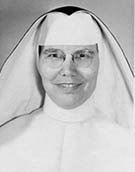
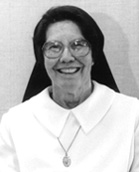
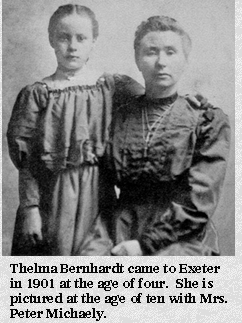 Thelma Bernhardt lived in the home of Peter and Elizabeth Michaely and their son Henry.
Thelma's ambition to become a teacher was apparent at an early age. She was four years old when she come to live with her
new parents. Playing school was one of her favorite games. When playing by herself, she used corn cobs for her pupils. She
started to school at the age of five and spent many years of diligent study and still had the desire to become a teacher.
While in high school she started to work her way through school. Her evenings and Saturdays were spent as a waitress at a
hotel in Exeter. This enabled her to earn the tuition money to attend Normal Training School. After graduating from school
she was prepared to teach in the rural schools in Nebraska.
Thelma Bernhardt lived in the home of Peter and Elizabeth Michaely and their son Henry.
Thelma's ambition to become a teacher was apparent at an early age. She was four years old when she come to live with her
new parents. Playing school was one of her favorite games. When playing by herself, she used corn cobs for her pupils. She
started to school at the age of five and spent many years of diligent study and still had the desire to become a teacher.
While in high school she started to work her way through school. Her evenings and Saturdays were spent as a waitress at a
hotel in Exeter. This enabled her to earn the tuition money to attend Normal Training School. After graduating from school
she was prepared to teach in the rural schools in Nebraska.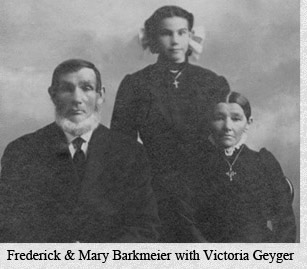 The
The
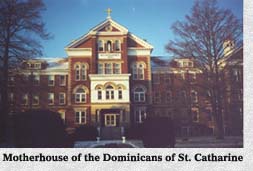 As a professed Sister, I joined the other professed sisters at
the Motherhouse and was assistant procurator. Since the novitiate was getting smaller I was also taking the milk room duty
and later the Taylor Ice Cream Freezer was installed. Then we had ice cream at least twice a week.
As a professed Sister, I joined the other professed sisters at
the Motherhouse and was assistant procurator. Since the novitiate was getting smaller I was also taking the milk room duty
and later the Taylor Ice Cream Freezer was installed. Then we had ice cream at least twice a week.